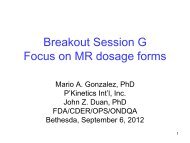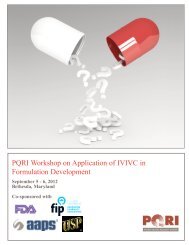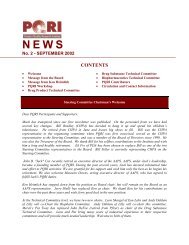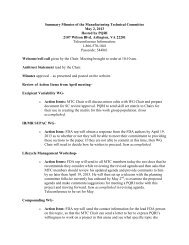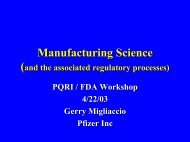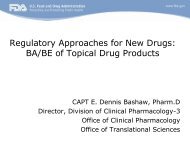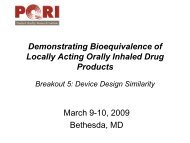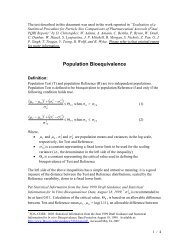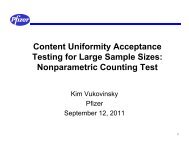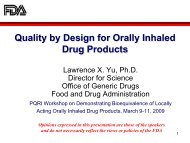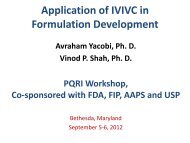Manufacturing Science (PDF) - PQRI
Manufacturing Science (PDF) - PQRI
Manufacturing Science (PDF) - PQRI
Create successful ePaper yourself
Turn your PDF publications into a flip-book with our unique Google optimized e-Paper software.
MANUFACTURING SCIENCEGerry Migliaccio
Agenda• Desired State• Culture Change• Key Points of Discussion• Group Specific Issues• Getting from Here to There• PAT• Interim Specifications
Desired State• Understanding what is critical for quality and design forquality• Agreement between Industry and FDA on a regulatorystrategy that is commensurate with the design• Regulatory relief where appropriate• <strong>Manufacturing</strong> science is dynamic and encompassesresearch, development, manufacturing, analytical• Open communication and trust• Agreed upon levels of information, data anddocumentation required for changes (specifications, newtechnology, PAT, comparability protocols)
Culture• Industry and Agency– Trust needs to be built– Shift from change is “bad” to change is “good”– Move from ‘compliance’ mindset to ‘quality by design’ mindset– Need to design the process, specifications, in-process controls thatare related to “fitness for use” (safety, efficacy, availability)– Increased “manufacturing science” and “quality systems” =decreased reliance on finished product testing– Documentation Data Knowledge• It is not question of submitting more and more data but sharing theright knowledge• Development report should demonstrate that we have designedquality into the product and the process• If we demonstrate that we have the right quality systems in place (i.e.change control, continuous improvement ) regulatory relief is given
KEY POINTS• <strong>Manufacturing</strong> <strong>Science</strong> is dynamic – the currentregulatory process is static– Applied the same way to all regardless of where youare with <strong>Manufacturing</strong> <strong>Science</strong>– Disproportional relationship between <strong>Manufacturing</strong><strong>Science</strong> and Regulatory Process• Definition: <strong>Manufacturing</strong> <strong>Science</strong>– More than just technology– Research, Development, <strong>Manufacturing</strong>, Analytical,Behavioral– ‘<strong>Science</strong>’ is well understood and accepted– Definition needs to be disseminated within all the areasof the company
KEY POINTS• Using in-process in-line/at-line/on-line analysis todemonstrate control of process and developknowledge that certain changes do not impactproduct safety and efficacy• More flexibility is needed in regulatory process• Risk-based approach will help the flexibility• A new mechanism for sharing knowledge isneeded: what knowledge and how much
Group specific issues• BIO– Years ago Biologics were not well characterized– That has changed – and they can be well defined andwell characterized• Should permit more flexibility in regulatory process– While products are unique there are some steps that arecommon leading to standardized approaches to changes• Fermentation, filtration• Animal Health– “Status quo” appears to be desired state because thereappears to be less value added in implementing newtechnology
From ‘Here” To ‘There”• Super supplement– Need a new way to supply information – a new process(multiple changes)– Industry gains a great deal of information and productknowledge in the first 12 months after approval–CAE: Changes Already Effected• Based on prior agreement• Use of INDs/INADs to share process developmentknowledge
From ‘Here’ To ‘There’• Expansion and modification of SUPACs– Go back and re-assess the guidance documents– Do we need a PAT SUPAC-like guidance – prepared in a similarmanner to the SUPAC for equipment changes?– Current perception: SUPAC doesn’t address multiple changes andrelief for specifications• If through new technology you have better quality assurance and areadding assurance you should have regulatory relief• Need to change how we look at specification life-cycle• Extensive use of statistical modeling for design ofprocesses and experiments• Address inconsistencies– Within agency and industry
• InspectionsFrom ‘Here’ To ‘There’– Broader pharmaceutical expertise needed– European model – 5 yrs. Industry (<strong>Manufacturing</strong>/Quality)experience– Training of inspectors• Bring training in house to FDA• Use Industry/Association experts to train• Leverage internal FDA experts– Expand current FDA expertise list• Industry experience emphasis for new inspectors• Sabbaticals: Industry to FDA– Training and expertise
From ‘Here’ To ‘There’• Inspections–PAIs• Consider moving to “for cause” PAIs• Expanding use of PAI “waiver” by district– General GMP/Quality Systems• Scheduled to have firm prepared and reduce timeand focus– People, data, plants and information ready – better process
From ‘Here’ To ‘There’• Risk assessment should take place at the reviewprocess to establish what needs to be done tosupport future changes.• Need to change the focus– Current focus is primarily on documentation– Documents are the goal not science– Backing off on documentation requirements will buildtrust and allow time for science
From ‘Here’ To ‘There’• If you can show there is an enhancement in qualityassurance – CAE or CBE• General protocols for implementing technology dependingon the type– rather than doing PAS on every product- havedefined the template for the product type that has hadagency review prior – then we can do a CBE/Annual report• Development reports– Needs to capture the failures as well– Important teaching tool
From ‘Here’ To ‘There’• Better communication– Between Industry and FDA– Internally (break down perceptions and misconceptionsof approaching FDA between R&D/Manuf/Regulatory• Evolve better guidance on changes specificallywith changes of RM suppliers or RM source(animal to vegetable derived)– Currently major regulatory burden• Better definition of change?
PAT• Not a requirement, not mandatory (IndustryAlignment)• Incentives for using, without penalties forremaining with the status quo• Need a flexible regulatory process to addressusing PAT in existing processes to replace currentmethods• Cannot apply today’s specifications which weredeveloped on a significantly smaller sample size– Need to determine how to address this– Impact on monograph
PAT• Process validation– If PAT can be considered continuous validation– does traditional process validation go away?• Clear it is not for everything– Not for every product or every company• It is not just about reducing finished producttesting, there are more benefits
Interim Specification(s)• Design of experiments and failure modeanalysis is crucial to assist in defining finalspecification• The data should tell us where interimspecifications are appropriate and wherethey are not• Approach similarly to Phase IVcommitments



